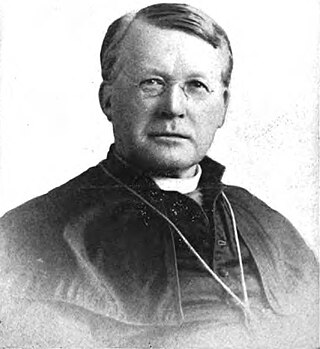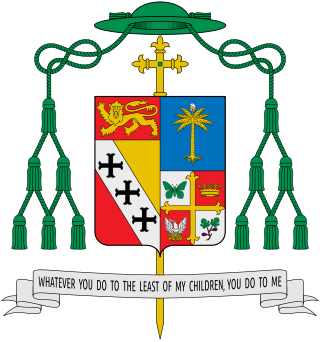
The Archdiocese of Atlanta is a Latin Church ecclesiastical jurisdiction, or archdiocese, of the Catholic Church in northern Georgia in United States. The archdiocese is led by a prelate archbishop, who also serves as pastor of the mother church, the Cathedral of Christ the King in Atlanta. As of 2023, the archbishop of Atlanta is Gregory Hartmayer.

The Diocese of Savannah is a Latin Church ecclesiastical territory, or diocese, of the Catholic Church in southern Georgia in the United States. The mother church of the diocese is Cathedral Basilica of Saint John the Baptist in Savannah. The patron saint is John the Baptist.

Saint Patrick Catholic Church, Honolulu is a parish in the Kaimuki district, in the East Honolulu Vicariate of the Roman Catholic Diocese of Honolulu, Hawaii. The church was consecrated under the title of St. Patrick, Bishop of Armagh. Its Romanesque architecture, as well as its fine ecclesiastical appointments such as stained glass windows and pipe organ, are attractive to prospective couples seeking nuptial rites.
John Francis Donoghue was an American prelate of the Roman Catholic Church. He served as the second bishop of the Diocese of Charlotte in North Carolina from 1984 to 1993 and as the fifth archbishop of the Archdiocese of Atlanta in Georgia from 1993 to 2004.

The Co-Cathedral of the Sacred Heart is a place of worship located at 1111 St. Joseph Parkway in downtown Houston. The co-cathedral seats 1,820 people in its 32,000-square-foot (3,000 m2) sanctuary. Together with the venerable St. Mary's Cathedral Basilica in Galveston, Sacred Heart serves more than 1.2 million Roman Catholics in the Archdiocese of Galveston-Houston.

The Cathedral of Christ the King in Atlanta, Georgia is the mother-church for the one million members of the Catholic Archdiocese of Atlanta. The cathedral is located at what is popularly called "Jesus Junction" on Peachtree Road, between East Wesley Road and Peachtree Road, in Atlanta's uptown Buckhead district. At present, the parish is one of the ten largest congregations in the United States, with over 5,500 families. Christ the King School also occupies the property, with an enrollment of approximately 600 students.

The Basilica of the Immaculate Conception is a historic Catholic church in Downtown Jacksonville, Florida, U.S. A parish church in the Diocese of St. Augustine, it represents Jacksonville's oldest Catholic congregation. The current building, dating to 1910, was added to the U.S. National Register of Historic Places in 1992 as the Church of the Immaculate Conception, and was named a minor basilica in 2013. It is located at 121 East Duval Street; its current pastor is Father Nick Bennett.

The Cathedral of the Sacred Heart, is the seat of the Bishop of the Roman Catholic Diocese of Pensacola-Tallahassee. It shares this distinction with the Co-Cathedral of Saint Thomas More in Tallahassee. The cathedral is named in honor of the Sacred Heart of Jesus, and is located in Pensacola, Florida.

The Catholic Metropolitan Archdiocese of Wellington is the Latin Church metropolitan archdiocese of New Zealand. Catholics number about 83,214. Parishes number 22 and the archdiocese extends over central New Zealand between Levin and Masterton in the north to Kaikoura to Westport in the south.

St. Francis de Sales Catholic Church, located in Mableton, Georgia, is the home of the Priestly Fraternity of St. Peter (FSSP) in the Roman Catholic Archdiocese of Atlanta. The community was founded in 1995 and established as a personal parish in 1999 by Archbishop John Francis Donaghue. The church (building) was purchased in 1999 and consecrated by Archbishop Donaghue in 2000.

Thomas Albert Andrew Becker was an American prelate of the Roman Catholic Church. He served as the first bishop of the Diocese of Wilmington (1868–1886) and the sixth bishop of the Diocese of Savannah in Georgia (1886–1899).
Religion in Atlanta, while historically centered on Protestant Christianity, now involves many faiths as a result of the city and metro area's increasingly international population. While Protestant Christianity still maintains a strong presence in the city, in recent decades Catholic Christians have gained a strong foothold due to migration patterns. Atlanta also has a considerable number of ethnic Christian congregations, such as Korean Baptist, Methodist, and Presbyterian Churches, the Tamil Church Atlanta, Telugu Church, Hindi Church, Malayalam Church, Ethiopian, Chinese, and many more traditional ethnic religious groups. Large non-Christian faiths are present in the form of Buddhism, Judaism and Hinduism. Overall, there are over 1,000 places of worship within Atlanta.

The Basilica of St. Joseph is a Roman Catholic church located in Alameda, California. Its history dates back to early settlement of the City of Alameda, California. A former mission church of St. Anthony's in Oakland, the parish of St. Joseph's was established in 1885. It is part of the Diocese of Oakland. The Basilica was added to the National Register of Historic Places on September 18, 1978.

The Shrine of the Immaculate Conception is a Roman Catholic church located at 48 Martin Luther King Jr. Drive SW in downtown Atlanta, Georgia, United States. The current church building was completed in 1873 and is the oldest church in Atlanta, as well as one of the oldest standing buildings in the city. It was added to the National Register of Historic Places in 1976.
Francis Edward Hyland was an American prelate of the Roman Catholic Church. He served as bishop of what was then the Diocese of Atlanta in Georgia from 1956 to 1961. He previously served as an auxiliary bishop of the Diocese of Savannah-Atlanta from 1949 to 1956.

John Edward Gunn was an Irish-born prelate of the Catholic Church. He served as Bishop of Natchez from 1911 until his death in 1924.

The Church of the Sacred Heart of Jesus is a Roman Catholic parish church, located in Hell's Kitchen/Clinton, Manhattan, New York City. Founded in 1876, it is a parish of the Archdiocese of New York and is located at 457 West 51st Street. Sacred Heart of Jesus School is located at 456 West 52nd Street. Since 2009, the pastor has been the Rev. Gabriel Piedrahita.
The Church of Our Lady of Mercy is a Catholic church located in Port Chester, New York. Having been founded as a parish in 1834, the present church building was constructed in 1934 in the Romanesque style. It is the parish church of the Parish of St. John Bosco, which is the product of the merger of Port Chester's four Catholic parishes.

Sacred Heart Knanaya Catholic Church located in Maywood, Illinois in the United States is the first Knanaya Catholic Church established outside the juridical boundary of the Syro-Malabar Catholic Archeparchy of Kottayam. This church is also the first church of the Knanaya Region under the St. Thomas Syro-Malabar Catholic Diocese of Chicago. The migrants from the Archdiocese of Kottayam living in Illinois, Indiana, and Wisconsin were members of this parish at the time of its establishment on 24 September 2006. The parishioners were formerly members of the Knanaya Catholic Mission established by the Archdiocese of Chicago since 28 October 1983. Later another church was established in Morton Grove on 18 July 2010 for the parishioners living in the north side of 90 Expressway. The church was elevated as a forane church by Bishop Mar Jacob Angadiath on 22 March 2015. The parish servers around 400 Knanaya Catholic families.

Jacques Eric Fabre-Jeune, C.S., known before May 2022 as Jacques Fabre, is a Haitian-American prelate of the Catholic Church who has served as Bishop of Charleston since 2022.



















